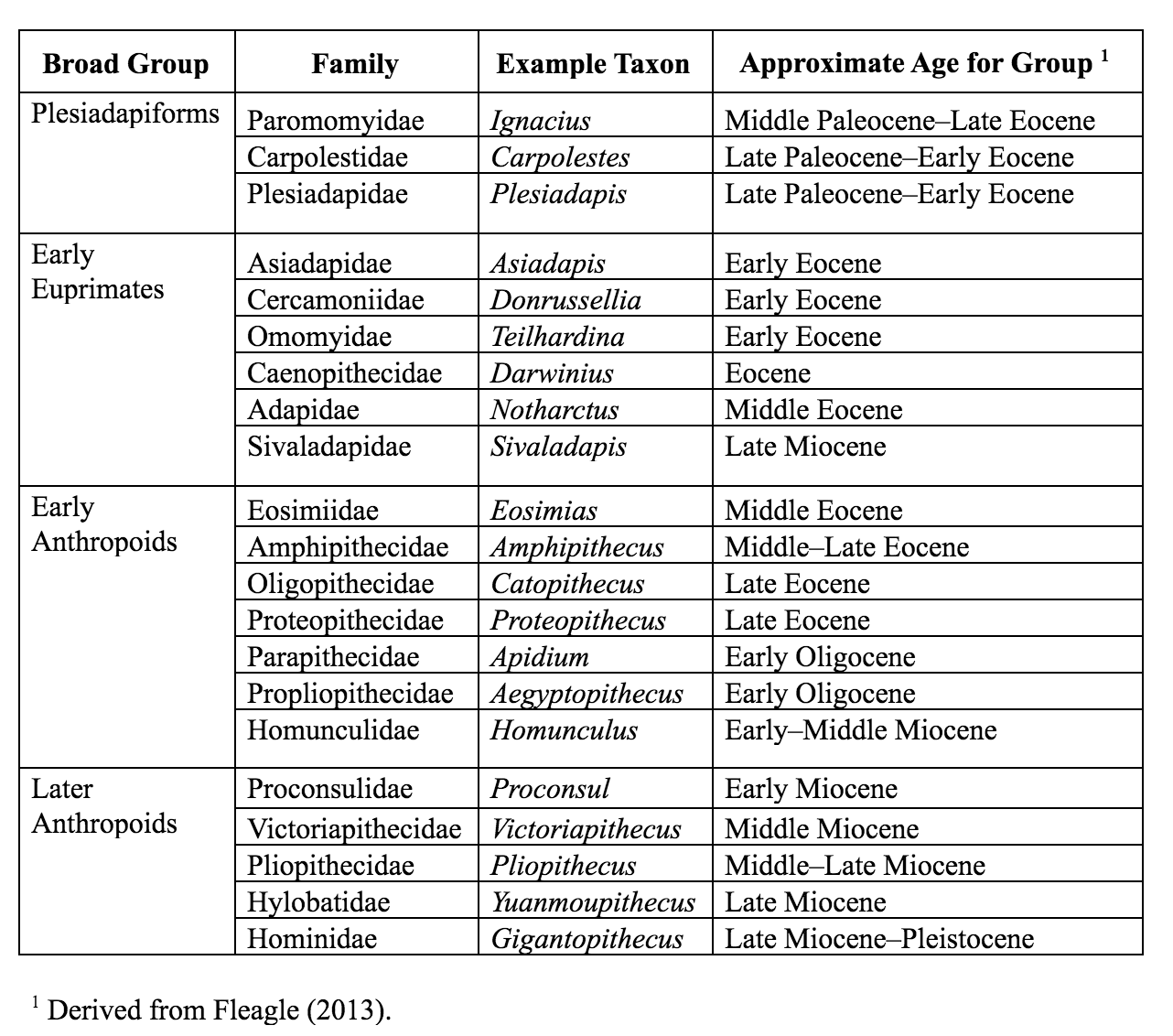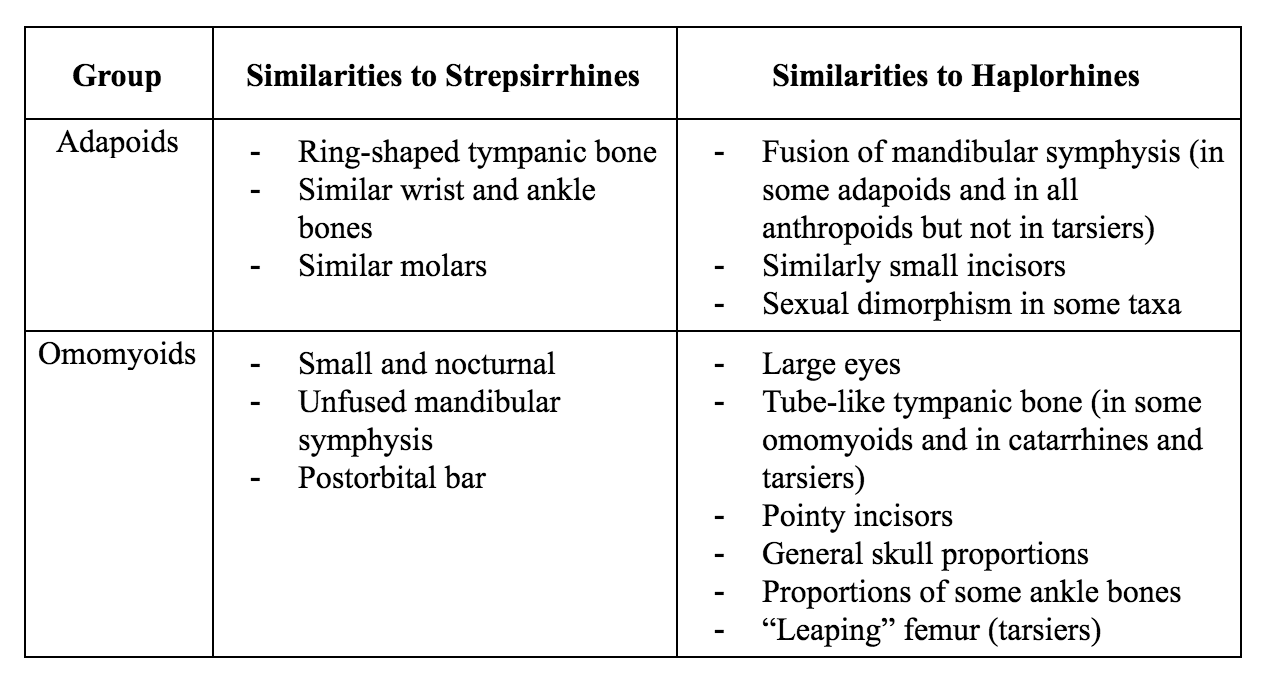GLOSSARY
Adapoidea: Order: Primates. One of the earliest groups of euprimates (true primates; earliest records from the early Eocene).
Anthropoids: Group containing monkeys and apes, including humans.
Auditory bulla: The rounded bony floor of the middle ear cavity.
Catarrhines: Order: Primates; Suborder: Anthropoidea; Infraorder: Catarrhini. Group containing Old World monkeys and apes, including humans.
Convergent evolution: The independent evolution of a morphological feature in animals not closely related (e.g., wings in birds and bats).
Crown group: The smallest group, or clade, that contains the last common ancestor of all extant (living) members and all of that ancestor's descendants. Extinct taxa can be part of a crown group. For example, the extinct dodo is a descendant of the last common ancestor of all living birds, as such it belongs to the bird crown group.
Diagnosis: The identifying features that allow you to recognize a member of a group.
Diffuse coevolution: The ecological interaction between whole groups of species (e.g., primates) with whole groups of other species (e.g., fruiting trees).
Ectotympanic bone: Bony ring or tube that holds the tympanic membrane (eardrum).
Euprimates: Order: Primates. True primates or primates of modern aspect.
Haplorhines: Group containing catarrhines, platyrrhines, and tarsiers.
Mandibular symphysis: Fibrocartilaginous joint between the left and right mandibular segments, located in the midline of the body.
Old World: Africa and Eurasia.
Omomyoidea: Order: Primates; Superfamily: Omomyoidea. One of the earliest groups of euprimates (true primates; earliest record in the early Eocene).
Petrous bone: Petrous portion of the temporal bone. It houses the inner ear apparatus, among other things.
Plagiaulacoid: Dental condition where at least one of the lower cheek-teeth (molars or premolars) is a laterally compressed blade.
Platyrrhines: Order: Primates; Suborder: Anthropoidea; Infraorder: Platyrrhini. Group containing New World monkeys.
Plesiadapiforms: Order: Plesiadapiformes. Archaic primates or primate-like placental mammals (Early Paleocene–Late Eocene).
Stem group: Taxa that are basal to a given crown group (clade) but are more closely related to the given crown group than to any other living crown group. All members of a stem group are extinct and only exist in the fossil record.
Strepsirrhines: Order: Primates; Suborder: Stresirrhini. Group containing lemurs, lorises, and galagos (does not include tarsiers).
FOR FURTHER EXPLORATION
Beard, Chris 2004. The Hunt for the Dawn Monkey: Unearthing the Origins of Monkeys, Apes, and Humans. Berkeley: University of California Press.
Begun, David R. 2010. Miocene Hominids and the Origins of the African Apes and Humans. Annual Review of Anthropology 39: 67–84.
Fleagle, John G. 2013. Primate Adaptation and Evolution. Third edition. San Diego, CA: Academic Press.
Gebo, Daniel L., ed. 1993. Postcranial Adaptations in Nonhuman Primates. Dekalb: Northern Illinois University Press.
Godfrey, Laurie R., and William L. Jungers. 2002. Quaternary Fossil Lemurs. In The Primate Fossil Record, edited by Walter C. Hartwig, 97–121. Cambridge: Cambridge University Press.
Godinot, Marc. 2006. Lemuriform Origins as Viewed from the Fossil Record. Folia Primatologica 77 (6): 446–464.
Kay, Richard F. 2018. 100 Years of Primate Paleontology. American Journal of Physical Anthropology 165 (4): 652–676.
Marivaux, Laurent. 2006. The Eosimiid and Amphipithecid Primates (Anthropoidea) from the Oligocene of the Bugti Hills (Balochistan, Pakistan): New Insight into Early Higher Primate Evolution in South Asia. Palaeovertebrata, Montpellier 34 (1–2): 29–109.
Martin, R. D. 1990. Primate Origins and Evolution, a Phylogenetic Reconstruction. Princeton: Princeton University Press.
Rose, Kenneth D., Marc Godinot, and Thomas M. Bown. 1994. The Early Radiation of Euprimates and the Initial Diversification of Omomyidae. In Anthropoid Origins: The Fossil Evidence, edited by John G. Fleagle and Richard F. Kay, 1–28. New York: Plenum Press.
Ross, Callum F. 1999. How to Carry Out Functional Morphology. Evolutionary Anthropology 7 (6): 217–222.
Seiffert, Erik R. 2012. Early Primate Evolution in Afro-Arabia. Evolutionary Anthropology: Issues, News, and Reviews 21: 239–253.
Szalay, Frederic S., and Eric Delson. 1979. Evolutionary History of the Primates. New York: Academic Press.
Ungar, Peter S. 2002. Reconstructing the Diets of Fossil Primates. In Reconstructing Behavior in the Primate Fossil Record, edited by Joseph Plavcan, Richard F. Kay, William Jungers, and Carel P. van Schaik, 261–296. New York: Kluwer Academic/Plenum Publishers.



